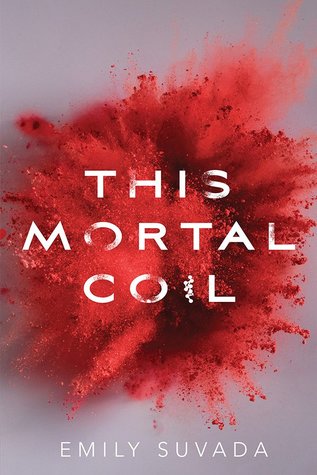Welp, this is going to be hard to review without spoilers. But I’ll do my best to segregate the spoilers from the non-spoilers in a secure bunker where contamination won’t be possible. (That’s a humorous This Mortal Coil joke for you.)

Catarina Agatta has spent the last two years fending for herself after the dangerous corporation Cartaxus showed up and took away her only companions: Lachlan Agatta the world’s leading gene-coder and may be the planet’s only hope for wiping out the deadly Hydra virus. Then a supersoldier named Cole arrives at Cat’s house with the news that her father has died and that Cole needs Cat’s help to finish creating the vaccine Lachlan started.
The fun of This Mortal Coil is that it’s often using your own expectations of the genre against you. What seems obvious in one moment turns out to be a function of what you thought a YA novel of this sort would be planning. As a reader of the end, I knew what some of the twists and turns were going to be (and some I guessed), but the fun of the book is still in the way This Mortal Coil plays with, shifts, and dissects some of the tropes of dystopian YA.
It’s also the first in a trilogy, which means that any spoilery complaints I have now may be addressed in subsequent books. But let’s get to ’em.
SPOILERS NOW
REALLY SPOILERS
To avoid the problem where your eye skips over some text and accidentally reads it without your conscious intention, I will quickly talk about a common misconception regarding news articles about things that have a genetic component but are not hereditary in the same predictable input-makes-output way that things like dimples and colorblindness are.
If you read an article that says something is 40% heritable, this does not mean you are 40% likely to inherit it, or that 40% of people who get a certain gene will end up with a corresponding trait. Instead it means that genes account for 40% of the variability that exists for that trait among the surveyed population. Among the surveyed population is an important phrase here, because heritability varies wildly depending on the population you are surveying. Now you know.
On to the spoilers!
So it turns out that Cartaxus is basically good and fine (except I am not sure the book ever resolved the question of whether they were keeping people out of the bunkers on a eugenic basis — is that still true?), and Catarina’s father is the bad guy. This is a fun twist in the context of other YA books, which do love their shadowy corporate/governmental organizations. In the context of actual corporations from real life, it’s — less delightful. Cat goes into the bunkers and finds them to be sunshiney paradises. The hacktivists turn out to have been working with Cartaxus all along to ensure that coding improvements to genes reach the maximum number of people inside and outside the bunker. Cartaxus is good! Hail Cartaxus.
IDK, y’all. My hope is that This Mortal Coil was the book that muddied the dichotomy of Cartaxus Bad, Father Good that Cat started out with; and that in the second book, the reverse dichotomy will likewise be muddied. Certainly there are flaws and errors by Cartaxus allies in This Mortal Coil, but I didn’t feel completely comfortable with the corporation’s perceived level of benevolence by the end of the book.